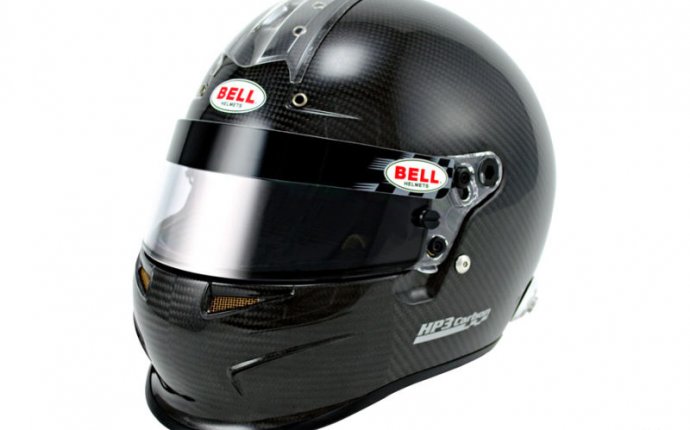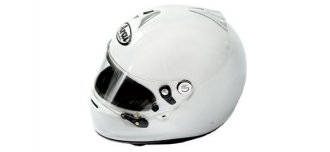
Dirt Track Racing helmets
 There are carbon-fiber helmets worn by pro racers that cost thousands of dollars. But the only amateurs likely to buy those are the guys who think it might be fun to put their Ferraris on the track. For most of us, the smart move is to buy an auto-racing helmet that meets the current Snell Memorial Foundation standards [see companion piece] and leaves enough money in the till for tires. All auto-racing helmets currently on sale meet the SA2005 guidelines, but we advise holding off until October, when the SA2010 standards take effect. Also, it’s possible to get away with using a motorcycle helmet at a track day, but the advantage of getting one with the SA auto-racing rating is that its lining is fireproof, very helpful if your vehicle bursts into flames. Plus, many events—SCCA and LeMons races, for example—insist on an SA-approved automotive helmet.
There are carbon-fiber helmets worn by pro racers that cost thousands of dollars. But the only amateurs likely to buy those are the guys who think it might be fun to put their Ferraris on the track. For most of us, the smart move is to buy an auto-racing helmet that meets the current Snell Memorial Foundation standards [see companion piece] and leaves enough money in the till for tires. All auto-racing helmets currently on sale meet the SA2005 guidelines, but we advise holding off until October, when the SA2010 standards take effect. Also, it’s possible to get away with using a motorcycle helmet at a track day, but the advantage of getting one with the SA auto-racing rating is that its lining is fireproof, very helpful if your vehicle bursts into flames. Plus, many events—SCCA and LeMons races, for example—insist on an SA-approved automotive helmet.
One of Arai’s less-expensive helmets is by far the priciest of those collected here. The Japanese company explains that’s because it uses only the costliest components and because these helmets are pretty much handmade. It’s certainly the lightest one in this roundup, at 3.4 pounds. It is also the snuggest of the four size-large helmets we tried, as well as the best fit for a skinny face. It feels more like a second skin than do the others. Staffers with bigger noggins say that with an Arai, they need to go plus-sized. The Arai’s cost is justified by a helmet that feels the best made of the four. This GP-6S, which is a brand-new model, has a positive-lock arrangement for the visor that’s intuitive and easy to use. Also, the helmet is predrilled for HANS (“head and neck support”) devices. ($899.95; www.araiamericas.com)
It feels more like a second skin than do the others. Staffers with bigger noggins say that with an Arai, they need to go plus-sized. The Arai’s cost is justified by a helmet that feels the best made of the four. This GP-6S, which is a brand-new model, has a positive-lock arrangement for the visor that’s intuitive and easy to use. Also, the helmet is predrilled for HANS (“head and neck support”) devices. ($899.95; www.araiamericas.com)
The Bell helmet feels big—it has the largest “eye port” of this group, and there is a big gap between the wearer’s chin and the front of the helmet. It is also quite tight fitting on the top of the head. Bell has fitted the shield with a friction system that allows the wearer to adjust the tension for multiple opening positions. Still, it doesn’t lock in as positively as the Arai shield. While the M-4 is quite a nice helmet—and comes predrilled for HANS posts—it is, at 3.8 pounds, the heaviest here. During severe track work, your neck will likely notice the extra weight. ($379.95; 800-237-2700; www.bellracing.com)
Still, it doesn’t lock in as positively as the Arai shield. While the M-4 is quite a nice helmet—and comes predrilled for HANS posts—it is, at 3.8 pounds, the heaviest here. During severe track work, your neck will likely notice the extra weight. ($379.95; 800-237-2700; www.bellracing.com)
Simpson makes helmets that certainly look different. The Diamondback is the choice of “The Stig, ” who drives the cars on the BBC’s Top Gear TV show, but it’s relatively expensive. We decided to try the company’s original Darth Vaderish bucket, the Super Bandit. The matte-black finish adds to the price. It is second-lightest of these helmets, at 3.7 pounds, and it fits larger heads well. Like the Bell and the Pyrotect, there’s a lot of room up front, and one or two testers preferred this to the snug fit of the Arai. The visor shield is hard to raise but comes with an antifog coating as standard. (On the Arai, an antifog shield costs more than $100.) It isn’t predrilled for HANS posts; ventilation is excellent. The Super Bandit isn’t for everyone, but it has the distinction of being, well, distinctive. ($449.95; 800-654-7223; www.teamsimpson.com)
Like the Bell and the Pyrotect, there’s a lot of room up front, and one or two testers preferred this to the snug fit of the Arai. The visor shield is hard to raise but comes with an antifog coating as standard. (On the Arai, an antifog shield costs more than $100.) It isn’t predrilled for HANS posts; ventilation is excellent. The Super Bandit isn’t for everyone, but it has the distinction of being, well, distinctive. ($449.95; 800-654-7223; www.teamsimpson.com)
The Pyrotect is the least costly helmet here, and it smells like it. The lining has a plasticky odor, although we expect it would wear away after a few hot, sweaty sessions at the track. Like the Bell and the Simpson, it feels roomy, with a large gap between the wearer’s head and the chin guard. The patented flow-through ventilation system works well, but it isn’t notably better than the others. This helmet is the third-heaviest here, just a fraction of an ounce lighter than the Bell. It has a feature the others don’t have: Replaceable cheek pads, which are included, allow for a better fit for differently shaped heads. ($248.45; 800-669-2355; www.pyrotect.com)









